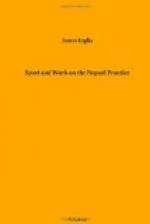Others, again, use circular casting nets, which they throw with very great dexterity. Gathering the net into a bunch they rest it on the shoulder, then with a circular sweep round the head, they fling it far out. Being loaded, it sinks down rapidly in the water. A string is attached to the centre of the net, and the fisherman hauls it in with whatever prey he may be lucky enough to secure.
As the waters recede during October, after the rains have ended, each runlet and purling stream becomes a scene of slaughter on a most reckless and improvident scale. The innumerable shoals of spawn and small fish that have been feeding in the rice fields, warned by some instinct seek the lakes and main streams. As they try to get their way back, however, they find at each outlet in each ditch and field a deadly wicker trap, in the shape of a square basket with a V-shaped opening leading into it, through which the stream makes its way. After entering this basket there is no egress except through the narrow opening, and they are trapped thus in countless thousands. Others of the natives in mere wantonness put a shelf of reeds or rushes in the bed of the stream, with an upward slope. As the water rushes along, the little fish are left high and dry on this shelf or screen, and the water runs off below. In this way scarcely a fish escapes, and as millions are too small to be eaten, it is a most serious waste. The attention of Government has been directed to the subject, and steps may be taken to stop such a reckless and wholesale destruction of a valuable food supply.
In some parts of Purneah and Bhaugulpore I have seen a most ingenious method adopted by the mullahs. A gang of four or five enter the stream and travel slowly downwards, stirring up the mud at the bottom with their feet. The fish, ascending the stream to escape the mud, get entangled in the weeds. The fishermen feel them with their feet amongst the weeds, and immediately pounce on them with their hands. Each man has a gila or earthen pot attached by a string to his waist and floating behind him in the water. I have seen four men fill their earthen pots in less than an hour by this ingenious but primitive mode of fishing. Some of them can use their feet almost as well for grasping purposes as their hands.
Another mode of capture is by a small net. A flat piece of netting is spread over a hoop, to which four or five pieces of bamboo are attached, rising up and meeting in the centre, so as to form a sort of miniature skeleton tent-like frame over the net. The hoop with the net stretched tight across is then pressed down flat on the bottom of the tank or stream. If any fish are beneath, their efforts to escape agitate the net. The motion is communicated to the fisherman by a string from the centre of the net which is rolled round the fisherman’s thumb. When the jerking of his thumb announces a captive fish, he puts down his left hand and secures his victim. The Banturs, Nepaulees, and other jungle tribes, also often use the bow and arrow as a means of securing fish.




